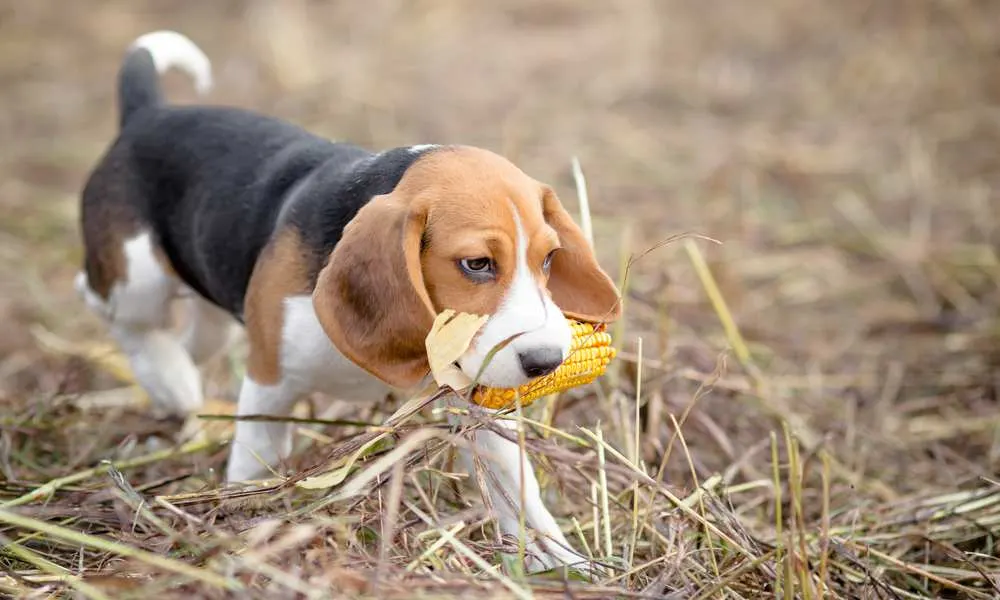As smart as our dogs are, supervising their own diet is one thing they can’t do. Dogs are perfectly happy to chow down on anything that looks or smells good, whether it’s a big juicy steak or a toxic bar of chocolate.
That’s why it’s up to dog owners to make sure their meals, snacks, and treats are safe to eat.
Luckily, commercially sold dog food and dog treats are made with dog-friendly ingredients. However, things tend to get more complicated if your dog’s snack was originally made for human consumption.
One human snack that dogs love is popcorn. It’s a type of food that requires very little prep, is sold in most supermarkets, and happens to be the perfect size for tossing into your dog’s waiting mouth.
Plus, popcorn is healthy for humans, so it must be fine for dogs, right?
Actually, the answer isn’t so simple.

Dogs And Corn
Before popcorn reaches its final, delicious state, it starts off as a plain kernel of corn. Plain corn is one of the world’s most popular cereal grains and is a staple food in many cultures. It’s also one of the most common ingredients in dog food.
Corn is a decent source of protein, carbs, and fiber. They also contain micronutrients like phosphorous and magnesium. On its own, corn can be nutritious and filling for humans. If the dog doesn’t have an allergy to corn, then it can be good for dogs, as well! However, most of the corn’s benefits will be canceled out of you including add-ins like butter, salt, and cheese.

Can Dogs Eat Popcorn?
Plain, air-popped popcorn is safe as an occasional treat for dogs. It doesn’t become so safe when it’s topped with butter and seasonings. While one or two pieces of buttered, salted popcorn are unlikely to cause much harm, the extra fat and salt can still cause intestinal upset. Over time, too many fatty, high-calorie treats can lead to obesity, which is why plain popcorn is best.
These days, flavored popcorn is all the rage. You might have seen some of the newer varieties in your local grocery’s popcorn aisle. Some of the more popular flavors include white cheddar, ranch, and even dill pickle! Even if flavored popcorn is one of your favorite snacks, don’t be tempted to share these with your dog.
A lot of the flavoring comes from salt, which can harm your dog in large amounts. Also, they may include garlic or onion powder as ingredients, which are extremely toxic to dogs.
The best thing we can do as dog owners is to keep our pets safe. The only 100% safe popcorn for dogs is plain, air-popped popcorn. Does anybody really prefer plain, unbuttered popcorn, though? I think not. Fortunately, our dogs don’t have to live on dog food and plain popcorn alone.

How To Pick Healthy Treats For Dogs?
Maintaining a healthy diet is just one-half of dog ownership. The other half (and the more fun half!) is giving treats. Treats are one of the most powerful training tools available to a dog owner. They are also useful for getting skittish shelter dogs to trust their new family members or reinforce the bond between pet and owner.
There is simply no way to raise a happy and healthy dog without treats, but it’s important to give treats responsibly, whether they are for dogs or humans. Here are some further tips to keep in mind if you’d like to share your treats with your four-legged best friend.
Remember The 10% Rule
Ideally, treats should represent 10% or less of a dog’s daily caloric intake. Unfortunately, there is no one-size-fits-all calorie guide for dogs. Each dog will have different caloric needs depending on its breed, age, activity level, and weight loss goals. Consult your veterinarian to determine your dog’s caloric needs. If you live in a household with multiple people, make sure everyone is on the same page about how many treats your dog is allowed to eat per day.
Include Fruits And Veggies
Fruits and vegetables are naturally very low in fat and calories, which is the main reason why salads have been a dieting staple since the time of our grandparents. If you don’t have any store-bought treats on hand, sliced fruits and vegetables can be a tasty and healthy alternative for your dog. You might find that your dog prefers fresh veggies over the over-processed treats that are sold on pet store shelves today. Some safe examples include:
- Cucumbers
- Apples
- Bananas
- Berries
- Carrots
- Green beans
- Broccoli
Some produce options can do more harm than good for your dog. This might be because dogs have trouble digesting certain foods, or those certain foods are actually toxic to dogs. The fruits and vegetables you should avoid giving your dog are:
- Grapes
- Raisins
- Avocados
- Garlic
- Onions
- Tomatoes
- Fruits with pits

Avoid Overfeeding
There’s a reason why treat is a “treat” and not “dinner.” Avoid overfeeding your dog by keeping treats small in size. That way, your dog will consume fewer calories per treat. The treats should be small enough to fit in the palm of your hand and for your dog to eat in one bite. Also, give treats one at a time instead of offering handfuls all at once. This allows you to control exactly how many treats your dog is receiving.
Consult A Vet
Let’s face it. We all know how easy it is to put on weight, and how hard it can be to keep it off. So just imagine how hard it can be for our dogs. Dogs can’t read nutrition labels like we can, which means it’s up to us to make sure our pets stay trim and active. Before making any changes to your dog’s diet, be sure to consult a vet. Keep all treats dog-friendly and under 10% of their daily caloric intake. And if you and your dog love popcorn, consider reaching for the plain popcorn on your next movie night so Fido can join in on the fun, too.
Learn More: What Can Dogs Eat? A Comprehensive List Of Dog-safe Foods

